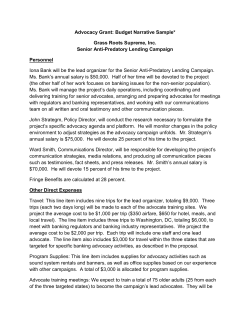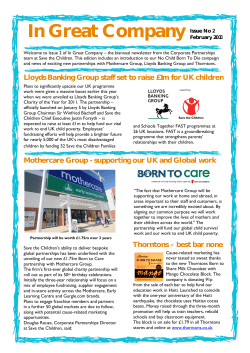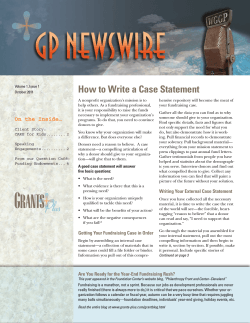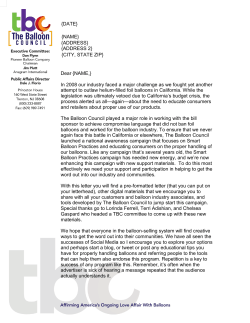
Advocacy & Lobbying Advocacy The fundamentals of a campaign
Advocacy & Lobbying Contents includes Advocacy The fundamentals of a campaign Lobbying How to lobby your elected official The contents of this resource have been compiled from a wide range of sources to cover topics requested by Action Partners attending the Oxfam International Youth Parliament (OIYP) Indigenous Australian Preparation Meeting July 2007 in Melbourne. It is important to note that this booklet is not a definitive guide nor is it an official publication of Oxfam Australia or OIYP, as such the views or opinions expressed are not those of OIYP or Oxfam Australia but are from a range of organisations that may be useful in shaping initiatives for social change. ADVOCACY (This section has been compiled from components of the Sri Lankan Youth Parliament (SLYP) Action Partner Skills Manual for young social activists, Module 4 - Advocacy, Lobbying and Awareness Raising.) WHAT ARE THE THREE STAGES OF CHANGE? Knowledge Attitude Practice / behaviour WHO CAN MAKE CHANGE HAPPEN? Primary targets - Decision makers Secondary targets - Groups that can influence the decision HOW TO MAKE CHANGE HAPPEN - SOME PRACTICAL WAYS TO SEE IT HAPPEN Communication Strategies • • • • Networking, coalition building Opinion surveys, research, publications Public meetings, rallies, protests and leaflet distribution E-mail, e-mail lists and web-sites Bureaucratic Strategies • • • Participation in government consultations Submissions to government or parliamentary committees Developing relationships with government officials Political Strategies • • • Working with elected officials to provide information and solutions Petitions and media pressure Letter writing campaigns targeting elected officials Legal Strategies • • Test case to review the legality of a government decision in the courts Pressure on governments to abide by international conventions Media Strategies • • Press releases, articles Photo opportunities PRIORITISING TARGET GROUPS In carrying out your ‘campaign’ you need to identify your target groups. This can depend on or be based on the following categories. Impact Easy to work with Those directly affected Some you can’t ignore Knowing when to switch targets There are some facts that affect your campaign that you will have no control over and these also need to be taken into consideration when planning and implementing your action campaign. . THE FUNDAMENTALS OF A CAMPAIGN (This section has been adapted from ‘a campaigning workshop based on the Control Arms Campaign’ presented by Brett Solomon and Sauro Scarpelli from Amnesty International for the International Youth Parliament Sydney July 2004.) Campaigning: An organised course of action to achieve change A campaign is: outcome driven a conversation with society it is often “public”, but not always OUTCOME DRIVEN • • • • • No campaign should start without clear goals. No campaign should start unless there is a possibility that it can be won. No campaign should start unless we intend to finish it off. Agree a campaign goal and then stick to it. The strategy may change with events, the goal rarely does. Look for a ‘critical-path’ - a trail of stepping stones. Stick at each stage until it is achieved. A CONVERSATION WITH SOCIETY/PUBLIC • • • • • Campaigns are communication exercises - a two-way process. Effective motivation needs simplicity in message and purpose. Start from where your audience is, not where you are. It may involve mobilisation of public opinion Do not try to communicate ‘the issue’, however tempting it may be. BUILDING A CAMPAIGN What do we want to change? – Campaign objective Who can make that change? – Power analysis What will make them change? – Advocacy and Lobbying How do we do it? – Campaign activities IMP A CT : change in people’s lives 1. What do we want to change? C H A N G E in policy or practice O U T C OME S of our activity A CT IV IT IE S & outputs + E x t e r na l F a c to rs INP UT S resources, context … THE COMPONENTS OF A CAMPAIGN • Activities The things we do: issue press-releases, write letters, hold demonstrations, lobby officials. • Outcomes The immediate result of our activity: media coverage, a president receiving 1000 postcards, a question asked in parliament. • Change The change in a government’s policy or practice or an individual’s behaviour. • Impact The lasting results, an improvement in individuals’ lives. SETTING THE CAMPAIGN OBJECTIVE • – – – – External factors: Gravity of problem Relevance Opportunity Link to larger strategy • – – – Internal Factors: Global priorities Organisational objectives Skills/expertise – PASSION! SET ONE CAMPAIGN GOAL _ – – If we set ourselves more than one campaign objective: It will be difficult to make choices. We will have problems communicating the campaign. – We will not know when we have won. SET SMART OBJECTIVES • • • • Specific Measurable Actionable Realistic • Time-limited When we evaluate our campaign, S.M.A.R.T. objectives will help us evaluate progress against our campaign objective. SPECIFIC & MEASURABLE • • • One clear campaign objective There should be no doubt about when the objective is achieved. What is a win? Get public support for...” or ”Raise awareness about...” are not ok. • Get a specific law passed through parliament” is better. ACHIEVABLE, REALISTIC & TIMELY • • • • • Can we actually DO something about it? How can we take action? Needs to be gauged in relation to external factors and opportunities. Maximum 2-3 years Otherwise it will become unmanageable. • If 2-3 years is unrealistic – cut up your campaign in smaller chunks. LOBBYING (This section has been adapted from ‘a campaigning workshop based on the Control Arms Campaign’ presented by Brett Solomon and Sauro Scarpelli from Amnesty International for the International Youth Parliament Sydney July 2004.) WHAT WILL MAKE THEM CHANGE? There are many approaches to effecting change – media, popular campaigns, membership action Advocacy - the act of supporting or arguing in favour of a cause, policy or idea. It is undertaken to influence public opinion and societal attitudes or to bring about changes in institutional, government, community or policies and practices. Lobbying - Process of informing and persuading those with power or influence to act. Why lobby? Membership/popular opinion give credibility. Security can make lobbying inappropriate or impossible Simple Influence Map National Media Catholic Arch-Bishop International Donors Judges Minister of Justice Family etc Part 2: Introduction to Campaigning Tools Senate Committee on Human Rights Chains of Influence Amnesty Senate Cttee Minister Amnesty Lawyers Courts Amnesty Parishioners Clergy Minister Arch-Bishop Minister Part 2: Introduction to Campaigning Tools MEETING WITH A DECISION MAKER • • • • • • • • • Why? Because they are responsible How? Research – getting to know the decision maker Research – getting to know the issue/arguments Making contact – how to arrange a meeting Who should meet – establishing trust Prepare – what do you want? Secondary aims? Meet – stick to the point, plan for different responses Follow-up – achieving results, maintain dialogue Next look at the practical aspects of lobbying in more detail HOW TO LOBBY YOUR ELECTED OFFICIAL (This information in this section is from a presentation on advocacy & lobbying – presented by the Public Interest Advocacy Centre, 7 July 2004 for the International Youth Parliament 2004.) Establish your agenda and goals. Listen well. Be prepared, but don’t feel that you need to be an expert. Don’t stay too long. Remember you are there to build a relationship. Follow-up is important. It would help if you are ready with all relevant documents and are in the correct mind frame for a meeting with whoever you intend to lobby. For that, you may need the following tools, resources and guides. LOBBYING KIT • • • • • Clear brief summary document No more than 1-2 pages User-friendly language Longer, supporting documents can be attached Include other relevant material THE DELEGATION • • • • • • • • • • • 2-4 appropriate and representative people Allocate roles & stick to them Have a mandate from your group & don’t exceed it Present a united front Don’t lie Look for opportunity for follow up Focus on outcome - be concrete Describe issue clearly in 3-5 main points Know what they can & can’t do Keep their motivations in mind Know your opposition & their arguments WHEN LOBBYING, Politicians • • • Work locally Be prepared for the meeting to be cut short Be aware of positions: backbenchers, party, Pre-election commitments, parliamentary committees • • • • Beware of being a purist Use their support to progress the issue Don’t show up the bureaucrats Try to identify a media angle Public Servants • Know government policy, Pre-election commitments etc • • • • • Assume they are an ally Identify who has responsibility for what Be aware of their constraints Don’t name-drop Have some understanding of the process Corporations • • • • • • • • Be organised, professional, pro-active Relate your issue to their core motivations: Company reputation Cost and benefits Demonstrate community support for your position Offer solutions Maintain dialogue with them Check your legal position Follow up • • • • Send a thank you letter which includes your understanding of what was discussed and agreed on Follow up issues which have arisen Feed back to your organisation Keep in contact with Minister’s staff REFERENCES This section has been compiled from components of the Sri Lankan Youth Parliament (SLYP) Action Partner Skills Manual for young social activists, Module 4 - Advocacy, Lobbying and Awareness Raising. A Campaigning Workshop Based on the Control Arms Campaign were compiled from a presentation by Brett Solomon and Sauro Scarpelli from Amnesty International for the International Youth Parliament Sydney July 2004 Advocacy & Lobbying – Presented by the Public Interest Advocacy Centre 7 July 2004 for the International Youth Parliament 2004 OTHER USEFUL RESOURCES OIYP case study collection: Awareness raising & behavioural change, Strategies for change in the OIYP Network, also available in Spanish and French. http://www.iyp.oxfam.org/news/publications/ Disability Awareness in Action – Consultation and Influence http://www.daa.org.uk/publications/ Reskit2.htm (available in English, Spanish & French) Richard Sayers, Principles of awareness raising for informational literacy, a case study. Bangkok: UNESCO Bangkok, 2006. http://unesdoc.unesco.org/images/0014/001476/147637e.pdf Compiled and adapted by Nicole Woodfield on behalf of the Oxfam International Youth Partnerships Program (OIYP), Indigenous Australian Preparation Meeting, July 2007, Melbourne.
© Copyright 2025





















